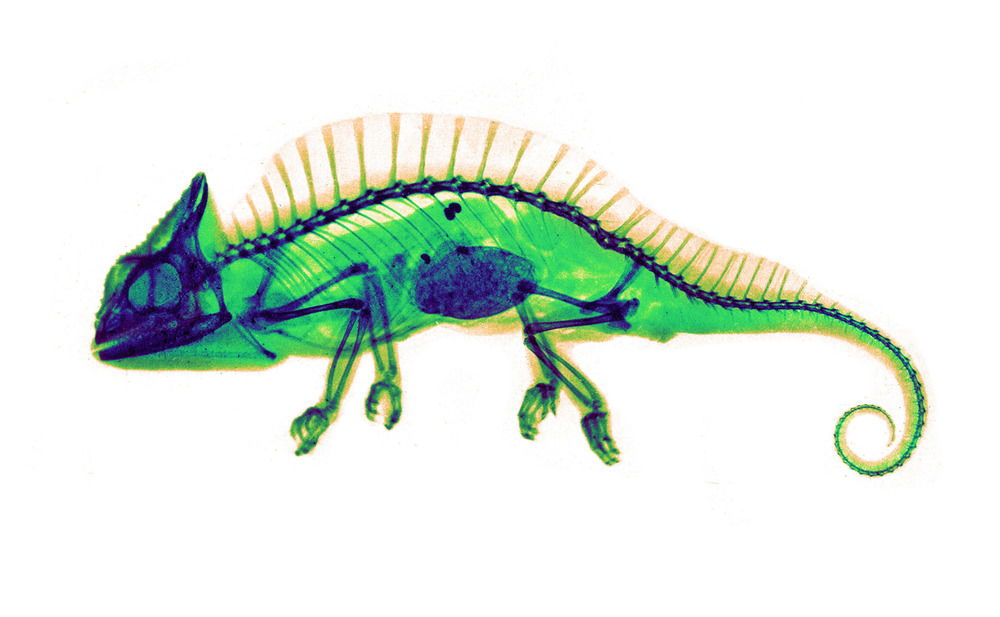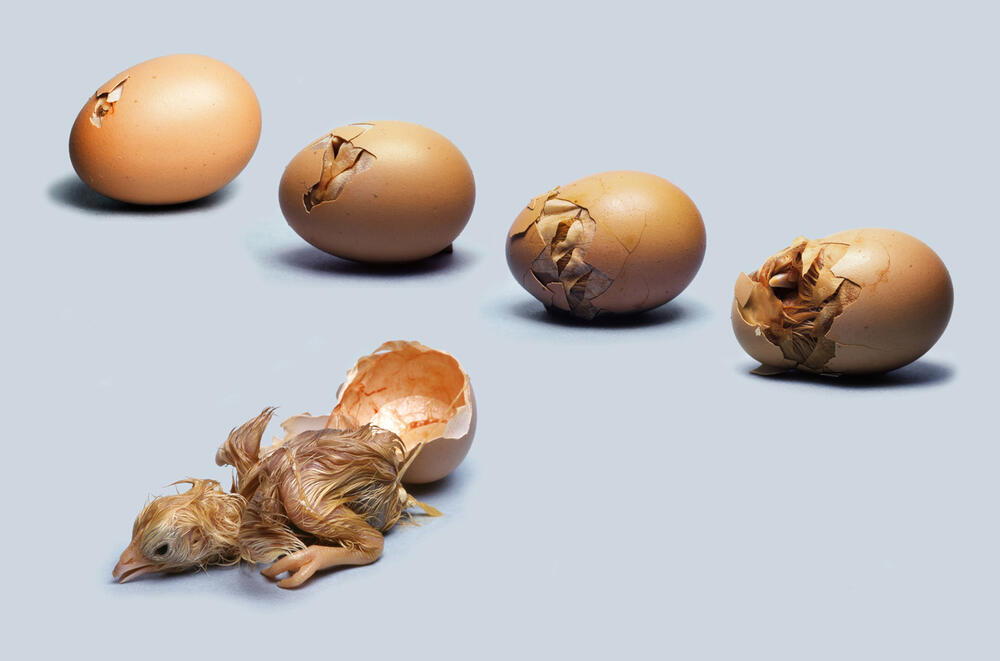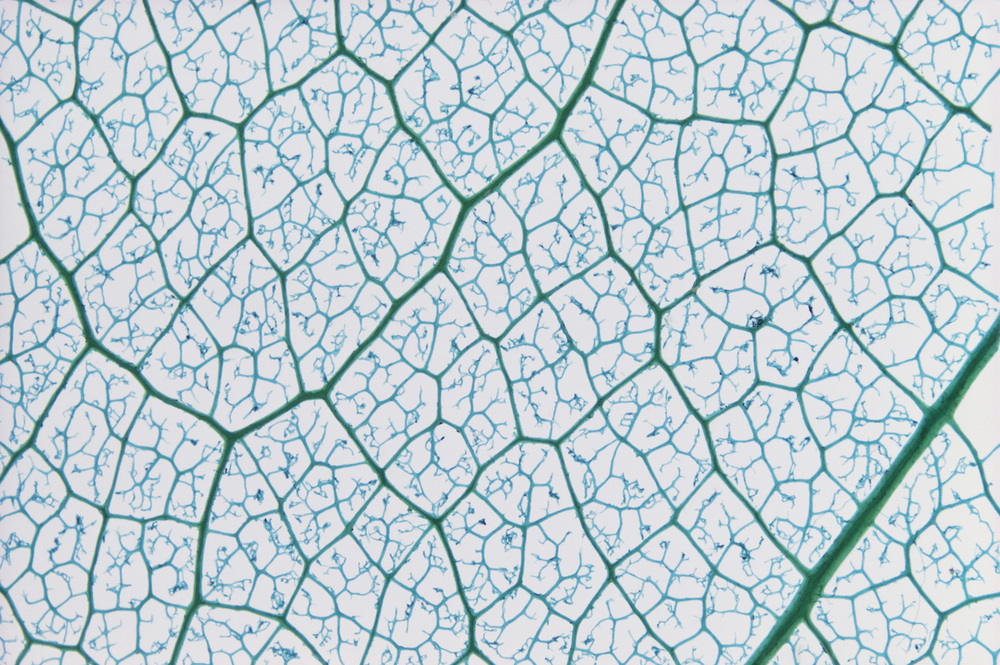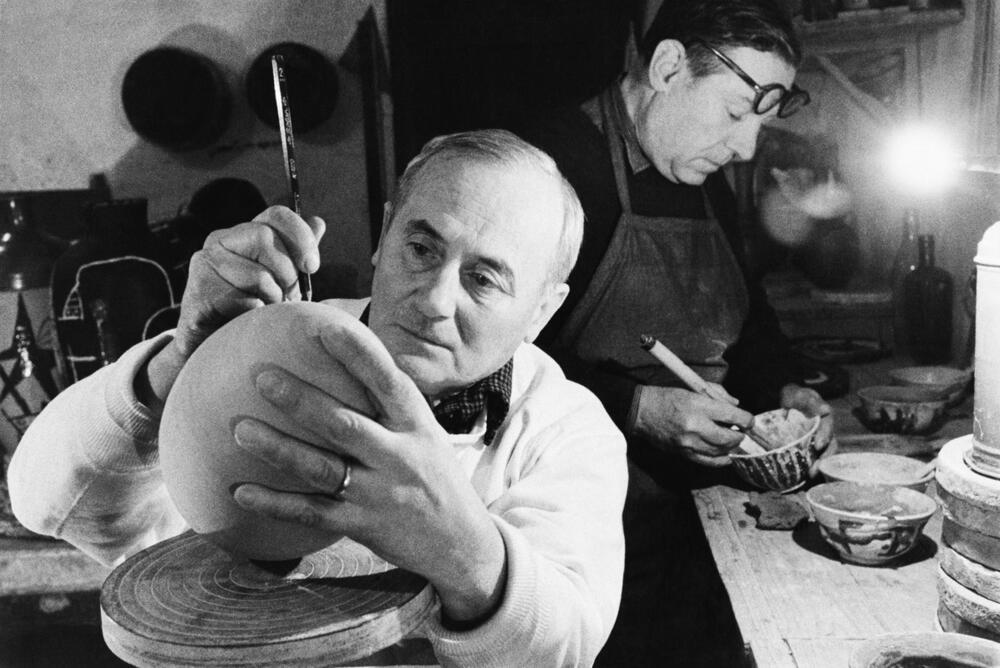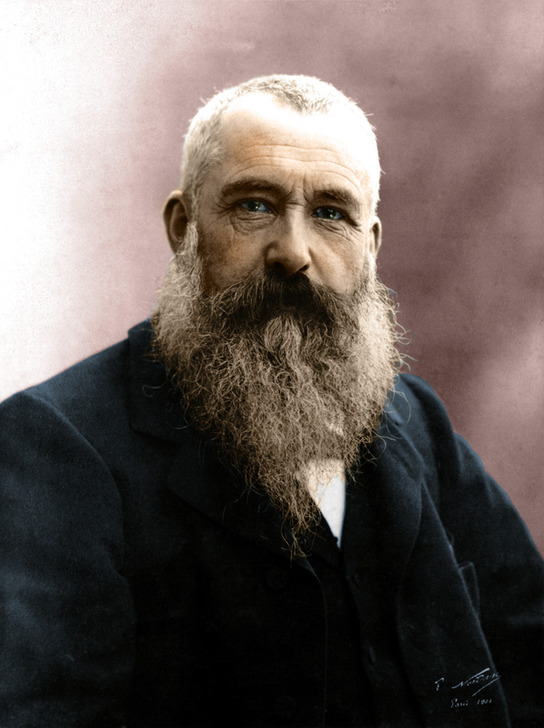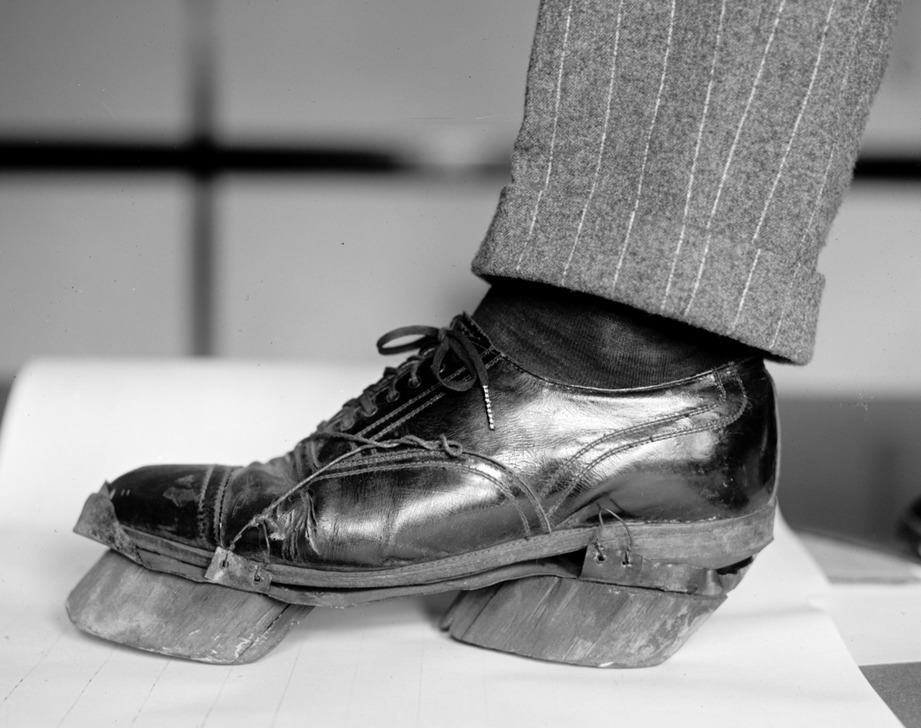Featured Source for December 2024: Science Source
20 November 2024
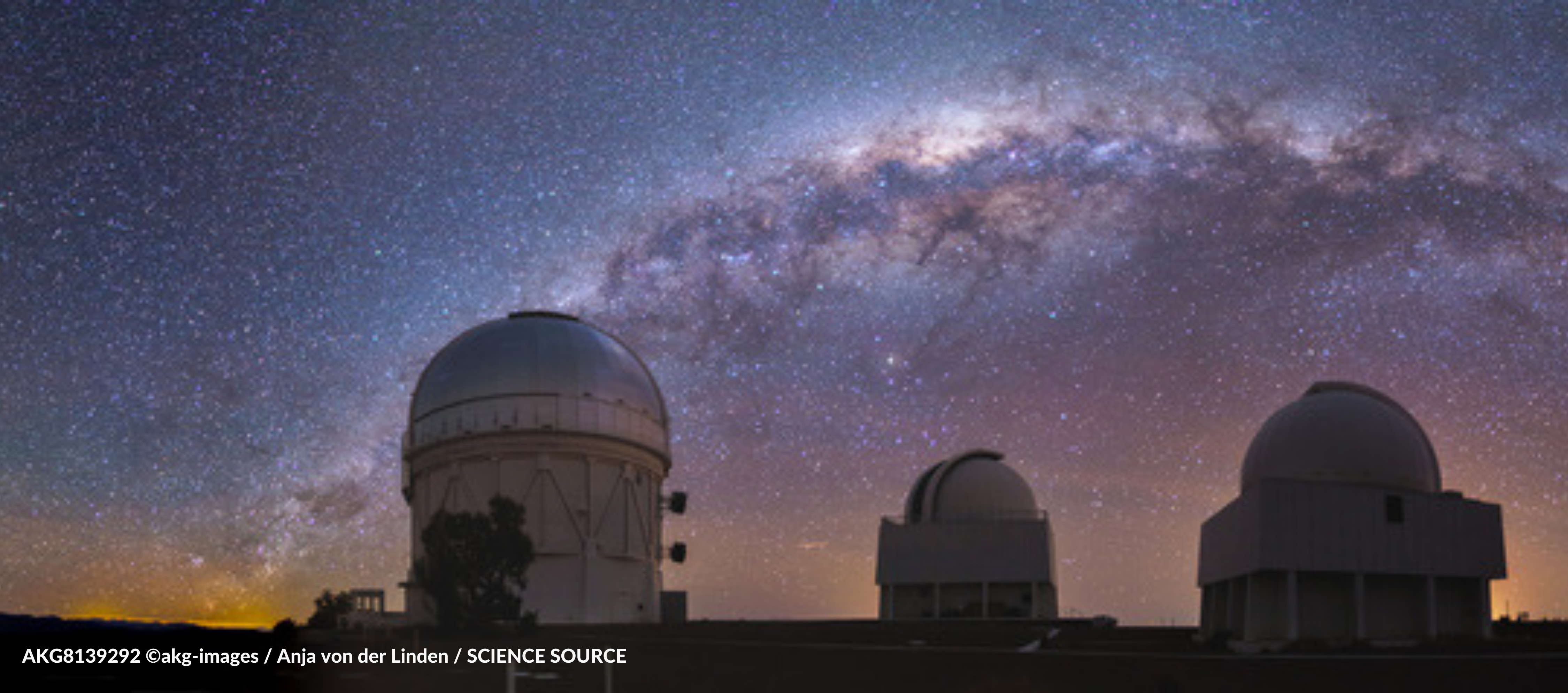.png)
akg-images is proud to represent Science Source.
Based in New York, Science Source boasts an impressive and diverse collection of scientific and medical images in all fields - from the natural and life sciences to social history, with detailed captions to support and elucidate each image.
akg-images has over 45,000 images from Science Source available for licensing. Scroll down to view a curated selection. You can tap here to see more, or browse the entire Science Source collection on the akg-images website.
Climate and weather
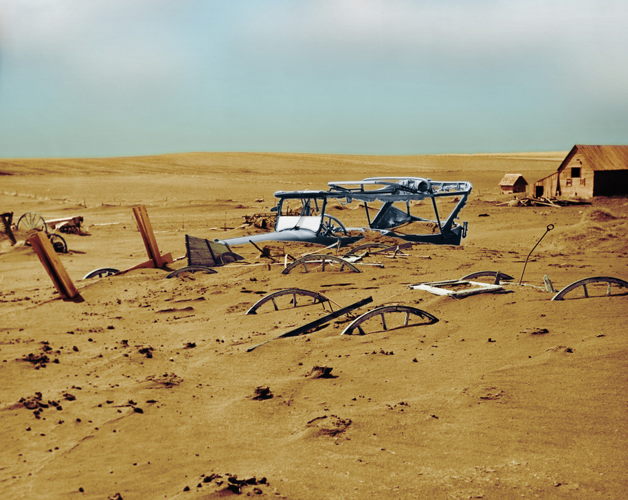.jpg) Machinery buried under dust and sand in a barn lot in Dallas, South Dakota, during the Dust Bowl.The Dust Bowl, or the Dirty Thirties, was a period of severe dust storms causing major ecological and agricultural damage to American and Canadian prairie lands from 1930 to 1936 (in some areas until 1940). The phenomenon was caused by severe drought coupled with decades of extensive farming without crop rotation, fallow fields, cover crops or other techniques to prevent wind erosion. Deep plowing of the virgin topsoil of the Great Plains had displaced the natural deep-rooted grasses that normally kept the soil in place and trapped moisture even during periods of drought and high winds. AKG8141254 ©akg-images / Omikron / SCIENCE SOURCE
Machinery buried under dust and sand in a barn lot in Dallas, South Dakota, during the Dust Bowl.The Dust Bowl, or the Dirty Thirties, was a period of severe dust storms causing major ecological and agricultural damage to American and Canadian prairie lands from 1930 to 1936 (in some areas until 1940). The phenomenon was caused by severe drought coupled with decades of extensive farming without crop rotation, fallow fields, cover crops or other techniques to prevent wind erosion. Deep plowing of the virgin topsoil of the Great Plains had displaced the natural deep-rooted grasses that normally kept the soil in place and trapped moisture even during periods of drought and high winds. AKG8141254 ©akg-images / Omikron / SCIENCE SOURCE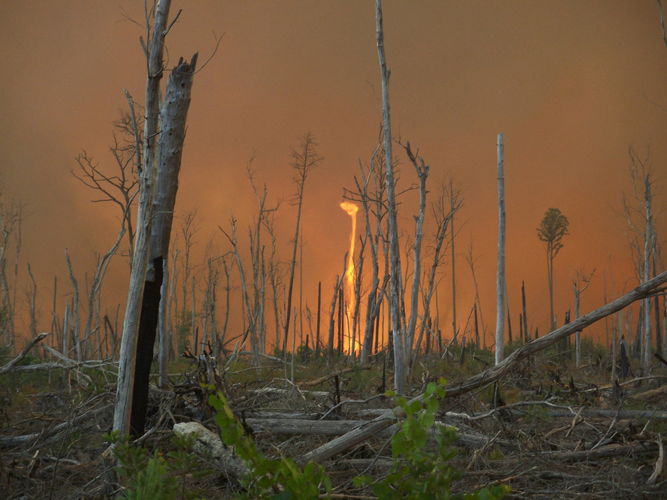.jpg) fire whirl rages off Corapeake Road in the Lateral West Wildlfire on Great Dismal Swamp National Wildlife Refuge. The fire burned in the scar of the 2008 South One Fire in a restoration area for Atlantic white cedar. When lightning struck in the Great Dismal Swamp National Wildlife Refuge on August 4, 2011, it hit land primed for wildfire. A previous fire in 2008 had killed trees and brush, leaving dead fuel in its wake. Grass and brush began to re-grow over the old burn scar, but in 2011, drought dried the plants and soil. AKG8140201 © akg-images / © USFWS/Greg Sanders/SCIENCE SOURCE
fire whirl rages off Corapeake Road in the Lateral West Wildlfire on Great Dismal Swamp National Wildlife Refuge. The fire burned in the scar of the 2008 South One Fire in a restoration area for Atlantic white cedar. When lightning struck in the Great Dismal Swamp National Wildlife Refuge on August 4, 2011, it hit land primed for wildfire. A previous fire in 2008 had killed trees and brush, leaving dead fuel in its wake. Grass and brush began to re-grow over the old burn scar, but in 2011, drought dried the plants and soil. AKG8140201 © akg-images / © USFWS/Greg Sanders/SCIENCE SOURCE The Johnstown Flood (or Great Flood of 1889 as it became known locally) occurred on May 31, 1889. It was the result of the catastrophic failure of the South Fork Dam situated on the Little Conemaugh River 14 miles upstream of the town of Johnstown, Pennsylvania, made worse by several days of extremely heavy rainfall. The dam's failure unleashed a torrent of 20 million tons of water from the reservoir known as Lake Conemaugh. The flood killed 2,209 people and caused $17 million in damages. It was the first major disaster relief effort handled by the new American Red Cross, led by Clara Barton. Support for victims came from all over the United States and 18 foreign countries. After the flood, survivors suffered a series of legal defeats in their attempts to recover damages from the dam's owners, prompting the development in American law changing a fault-based regime to strict liability. AKG5458682 ©akg-images / Science Source
The Johnstown Flood (or Great Flood of 1889 as it became known locally) occurred on May 31, 1889. It was the result of the catastrophic failure of the South Fork Dam situated on the Little Conemaugh River 14 miles upstream of the town of Johnstown, Pennsylvania, made worse by several days of extremely heavy rainfall. The dam's failure unleashed a torrent of 20 million tons of water from the reservoir known as Lake Conemaugh. The flood killed 2,209 people and caused $17 million in damages. It was the first major disaster relief effort handled by the new American Red Cross, led by Clara Barton. Support for victims came from all over the United States and 18 foreign countries. After the flood, survivors suffered a series of legal defeats in their attempts to recover damages from the dam's owners, prompting the development in American law changing a fault-based regime to strict liability. AKG5458682 ©akg-images / Science Source Hurricane Emilia (July 19th, 1994) over the Eastern Pacific Ocean, as seen from space. Massive storms like this were a common feature of the Jurassic. AKG5430581 ©akg-images / Science Source
Hurricane Emilia (July 19th, 1994) over the Eastern Pacific Ocean, as seen from space. Massive storms like this were a common feature of the Jurassic. AKG5430581 ©akg-images / Science Source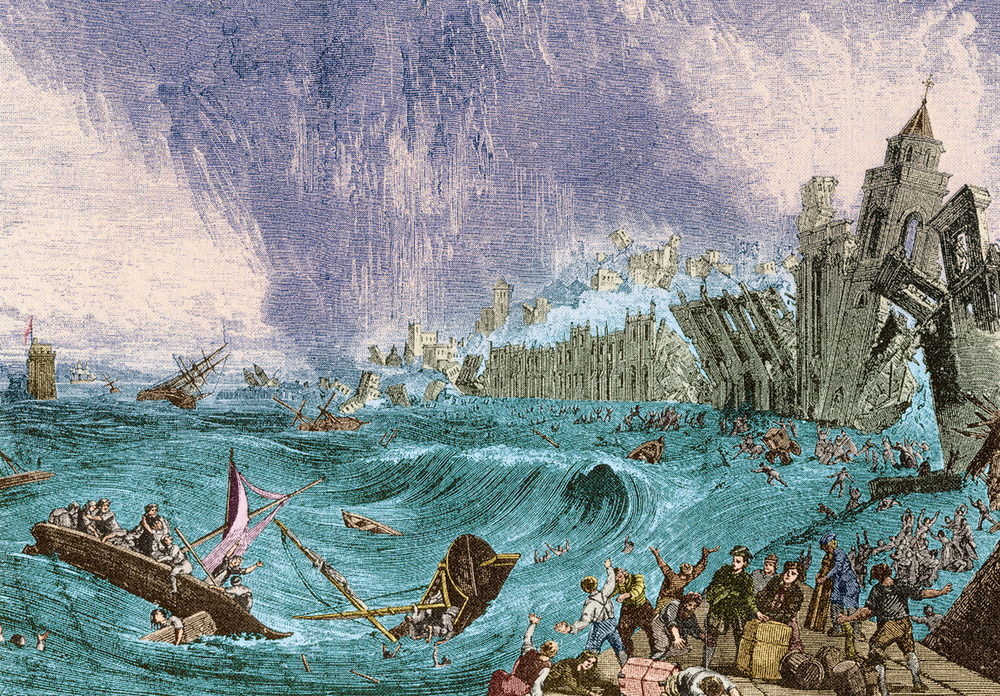 November 1, 1755. Shortly after the Lisbon earthquake struck the great city, a series of huge tsunami waves crashed over the harbor quays, engulfed the lower part of Lisbon on the shore of the Tagus, and submerged much of the lower part of the city including its newly built, marble quay of Cais De Pedra which disappeared into the river. The first three of these tsunami waves were the largest and completed the destruction brought about by the two earlier strong quake shocks. 20,000 more of the terrified survivors who had rushed to the open space of the docks and the waterfront quay for safety, lost their lives to these tsunami waves. All boats moored in Lisbon's harbor were destroyed. AKG5464192 © akg-images / Science Source
November 1, 1755. Shortly after the Lisbon earthquake struck the great city, a series of huge tsunami waves crashed over the harbor quays, engulfed the lower part of Lisbon on the shore of the Tagus, and submerged much of the lower part of the city including its newly built, marble quay of Cais De Pedra which disappeared into the river. The first three of these tsunami waves were the largest and completed the destruction brought about by the two earlier strong quake shocks. 20,000 more of the terrified survivors who had rushed to the open space of the docks and the waterfront quay for safety, lost their lives to these tsunami waves. All boats moored in Lisbon's harbor were destroyed. AKG5464192 © akg-images / Science Source Dried, cracked earth, in Bayou La Batre, Alabama. AKG8195693 ©akg-images / Maurice E. Landre / SCIENCE SOURCE
Dried, cracked earth, in Bayou La Batre, Alabama. AKG8195693 ©akg-images / Maurice E. Landre / SCIENCE SOURCE Haitian waterfront in ruins in the wake of Hurricane Flora in 1963. The storm produced winds of up to 120 miles per hour, produced storm surges of over 12 feet, and dropped torrential rain on the country, causing flash floods and mudslides. About 5,000 people died, and towns, cities and crops were entirely destroyed. AKG8125529 © akg-images / Omikron / SCIENCE SOURCE
Haitian waterfront in ruins in the wake of Hurricane Flora in 1963. The storm produced winds of up to 120 miles per hour, produced storm surges of over 12 feet, and dropped torrential rain on the country, causing flash floods and mudslides. About 5,000 people died, and towns, cities and crops were entirely destroyed. AKG8125529 © akg-images / Omikron / SCIENCE SOURCEIllustrations and Drawings
 Plate 17 “Siphonophorae”. Lithograph by Ernst Haeckel (German zoologist and natural philosopher, 1834–1919) from “Kunstformen der Natur” (1899–1904)).AKG7419139 ©akg-images / Science Source
Plate 17 “Siphonophorae”. Lithograph by Ernst Haeckel (German zoologist and natural philosopher, 1834–1919) from “Kunstformen der Natur” (1899–1904)).AKG7419139 ©akg-images / Science Source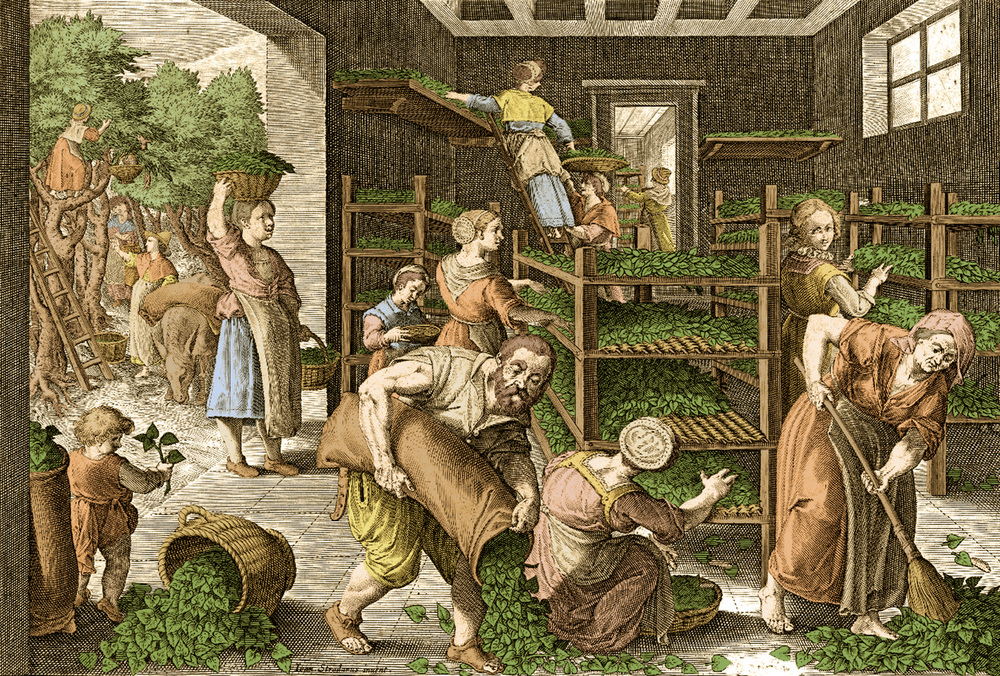.jpg) People gathering leaves from mulberry trees planted outside; to the right, a room with various shelves with silkworms on them; people arranging the leaves on the shelves to feed the silkworms. The production of silk originated in China in prehistoric times. Silk remained confined to China until the Silk Road opened at some point during the later half of the first millennium BC. The Crusades brought silk production to Western Europe, in particular to many Italian states, which saw an economic boom exporting silk to the rest of Europe. Changes in manufacturing techniques also began to take place during the Middle Ages, with devices such as the spinning wheel first appearing. Taken from Vermis serivs, The history of the silkworm and silk-spinning, engraving by Karel van Mallery, circa 1590-1600 AKG7420122 ©akg-images / Science Source
People gathering leaves from mulberry trees planted outside; to the right, a room with various shelves with silkworms on them; people arranging the leaves on the shelves to feed the silkworms. The production of silk originated in China in prehistoric times. Silk remained confined to China until the Silk Road opened at some point during the later half of the first millennium BC. The Crusades brought silk production to Western Europe, in particular to many Italian states, which saw an economic boom exporting silk to the rest of Europe. Changes in manufacturing techniques also began to take place during the Middle Ages, with devices such as the spinning wheel first appearing. Taken from Vermis serivs, The history of the silkworm and silk-spinning, engraving by Karel van Mallery, circa 1590-1600 AKG7420122 ©akg-images / Science Source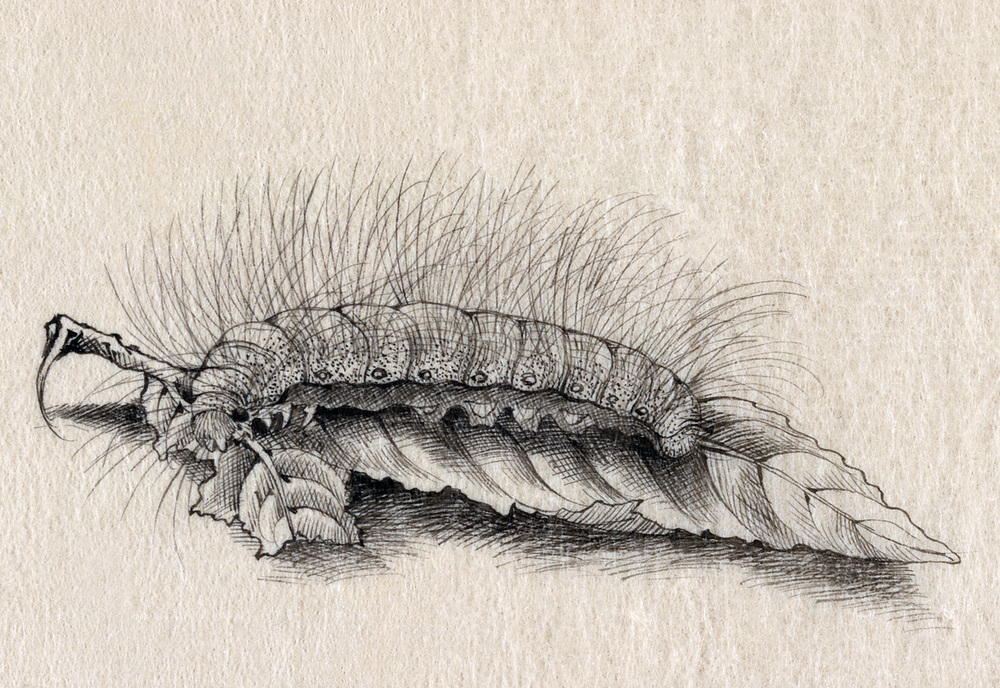 Silkworm, Silk Making in Japan, 1878. AKG7418760 ©akg-images / Science Source
Silkworm, Silk Making in Japan, 1878. AKG7418760 ©akg-images / Science Source A busy stacking room in the opium factory at Patna, India. Lithograph after W. S. Sherwill, c. 1850. AKG9036241 ©akg-images / Science Source
A busy stacking room in the opium factory at Patna, India. Lithograph after W. S. Sherwill, c. 1850. AKG9036241 ©akg-images / Science Source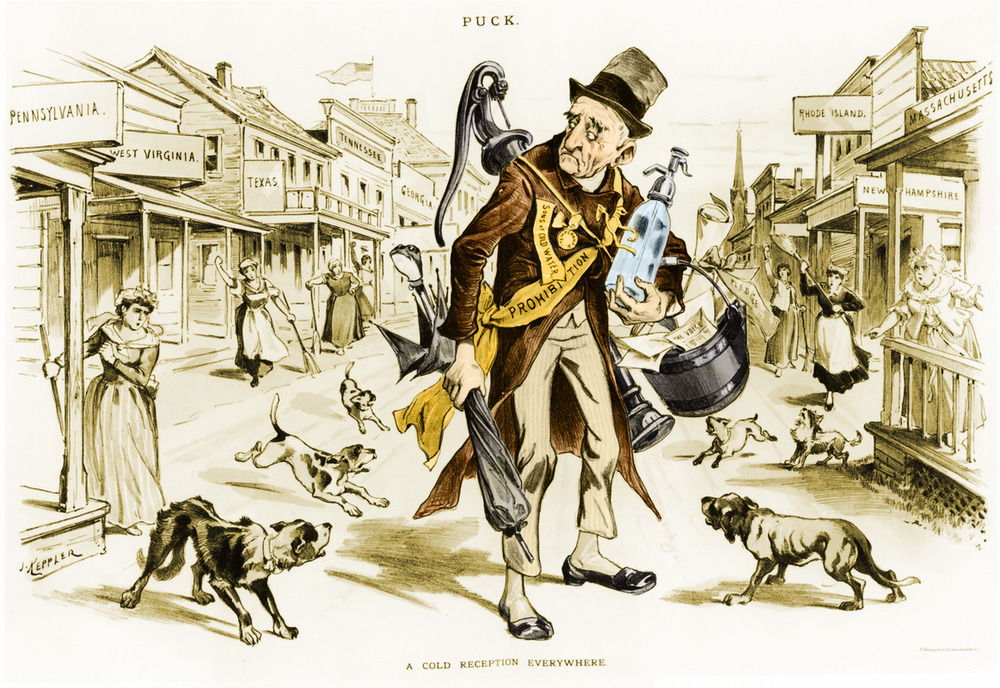 Political cartoon showing Old Man Prohibition receiving "a cold reception everywhere." AKG5441834 © akg-images / Science Source
Political cartoon showing Old Man Prohibition receiving "a cold reception everywhere." AKG5441834 © akg-images / Science Source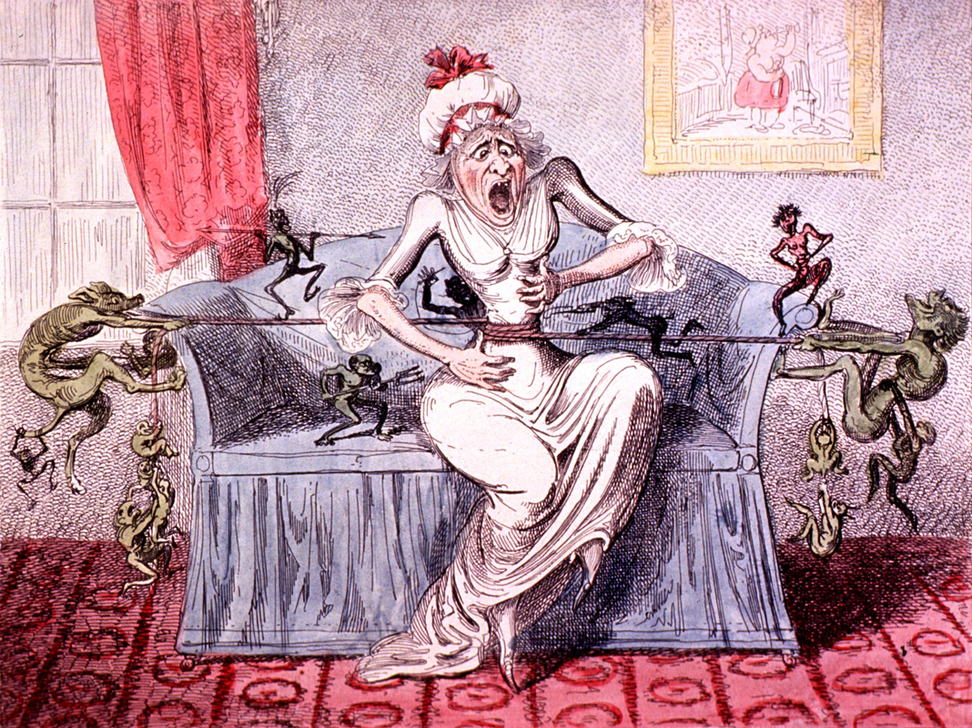 A woman sitting on a sofa is clutching her abdomen and shrieking from the pain resulting from a rope that is being pulled in opposite directions by little demons, thereby constricting her waist. Colic or cholic is a form of pain which starts and stops abruptly. It occurs due to muscular contractions of a hollow tube (colon, ureter, gall bladder, etc.) in attempt to relieve the obstruction by forcing content out. It may be accompanied by vomiting and sweating. Etching by George Cruikshank, 1819. AKG5463034 © akg-images / Science Source
A woman sitting on a sofa is clutching her abdomen and shrieking from the pain resulting from a rope that is being pulled in opposite directions by little demons, thereby constricting her waist. Colic or cholic is a form of pain which starts and stops abruptly. It occurs due to muscular contractions of a hollow tube (colon, ureter, gall bladder, etc.) in attempt to relieve the obstruction by forcing content out. It may be accompanied by vomiting and sweating. Etching by George Cruikshank, 1819. AKG5463034 © akg-images / Science SourceSpace
 Earth's Atmosphere Over Africa, Satellite Image The glow of Earth's atmosphere blankets the southeastern coast of Africa as seen in this satellite image from the International Space Station, orbiting 263 miles above Earth on July 30, 2021. AKG9036439 ©akg-images / science source
Earth's Atmosphere Over Africa, Satellite Image The glow of Earth's atmosphere blankets the southeastern coast of Africa as seen in this satellite image from the International Space Station, orbiting 263 miles above Earth on July 30, 2021. AKG9036439 ©akg-images / science source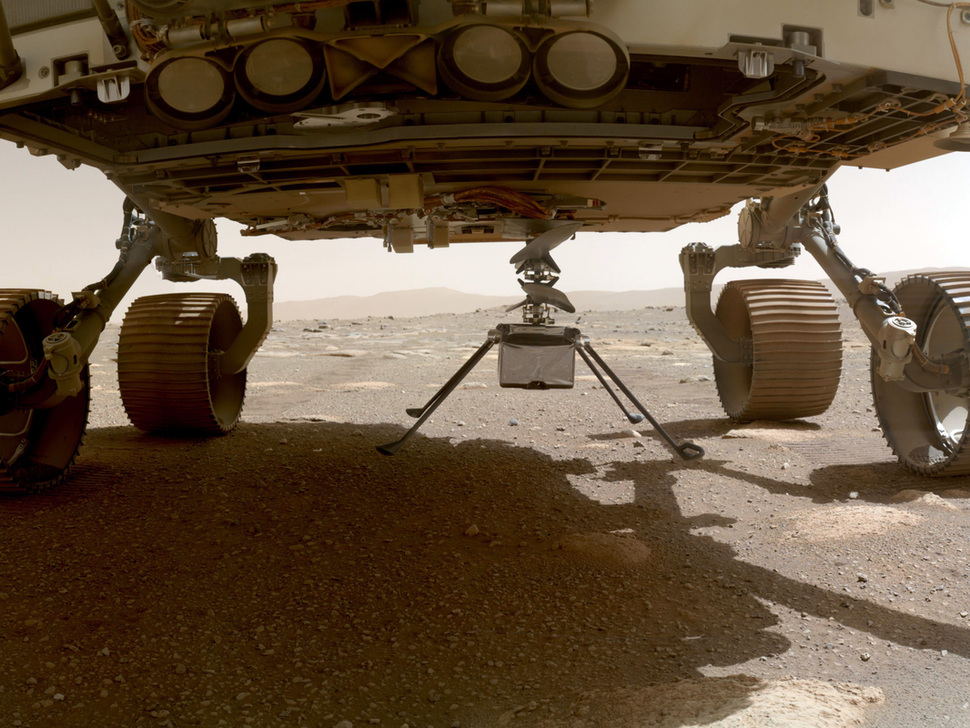 NASA's Ingenuity helicopter, with all four of its legs deployed, drops from the bottom of the Perseverance rover on March 30, 2021. This image was taken by the WATSON (Wide Angle Topographic Sensor for Operations and eNgineering) camera, located at the end of the rover's long robotic arm. AKG9036417 ©akg-images / Science Source
NASA's Ingenuity helicopter, with all four of its legs deployed, drops from the bottom of the Perseverance rover on March 30, 2021. This image was taken by the WATSON (Wide Angle Topographic Sensor for Operations and eNgineering) camera, located at the end of the rover's long robotic arm. AKG9036417 ©akg-images / Science Source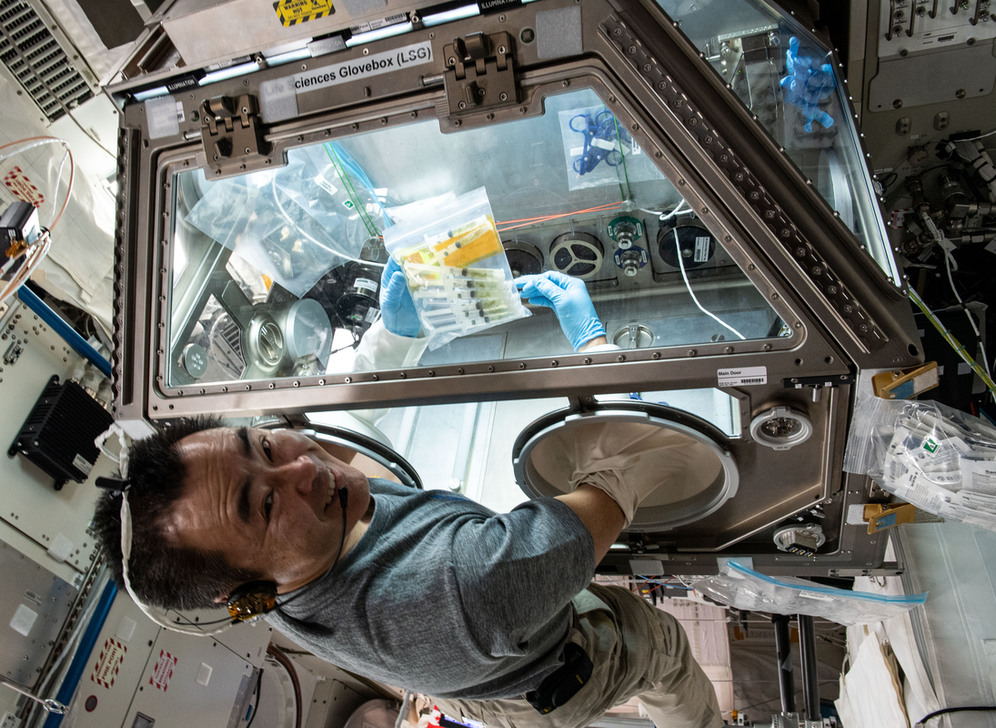 Expedition 65 Commander Akihiko Hoshide of the Japan Aerospace Exploration Agency (JAXA) studies tardigrades, also known as water bears, inside the Kibo laboratory module's Life Sciences Glovebox. The study seeks to identify genes that adapt best to the harsh environment of microgravity. July 13, 2021. AKG9036436 © akg-images / Science Source
Expedition 65 Commander Akihiko Hoshide of the Japan Aerospace Exploration Agency (JAXA) studies tardigrades, also known as water bears, inside the Kibo laboratory module's Life Sciences Glovebox. The study seeks to identify genes that adapt best to the harsh environment of microgravity. July 13, 2021. AKG9036436 © akg-images / Science Source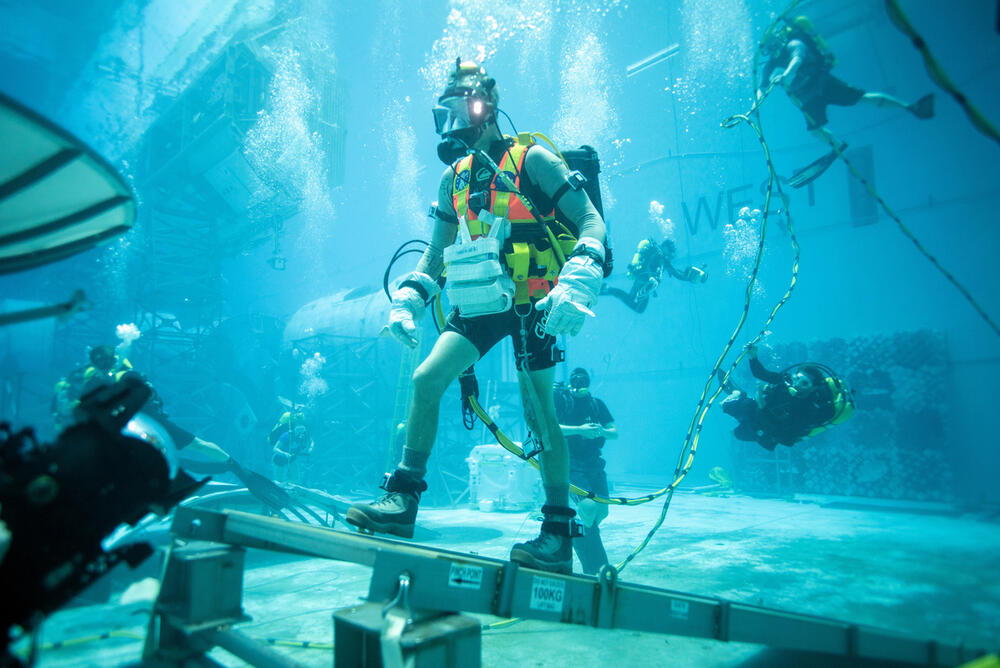 NASA astronauts train underwater in the Neutral Buoyancy Lab at the Johnson Space Center in Houston, Texas, September, 2019. These teams are in the early stages of evaluating how astronauts would live and work on the Moon. The astronauts are equipped with weighted vests and backpacks to simulate walking on the Moon, which has one-sixth the gravity of Earth. Astronauts Drew Feustel and Don Pettit are among those depicted in this image. AKG9036301 ©akg-images / Science Source
NASA astronauts train underwater in the Neutral Buoyancy Lab at the Johnson Space Center in Houston, Texas, September, 2019. These teams are in the early stages of evaluating how astronauts would live and work on the Moon. The astronauts are equipped with weighted vests and backpacks to simulate walking on the Moon, which has one-sixth the gravity of Earth. Astronauts Drew Feustel and Don Pettit are among those depicted in this image. AKG9036301 ©akg-images / Science SourceNature and Environment
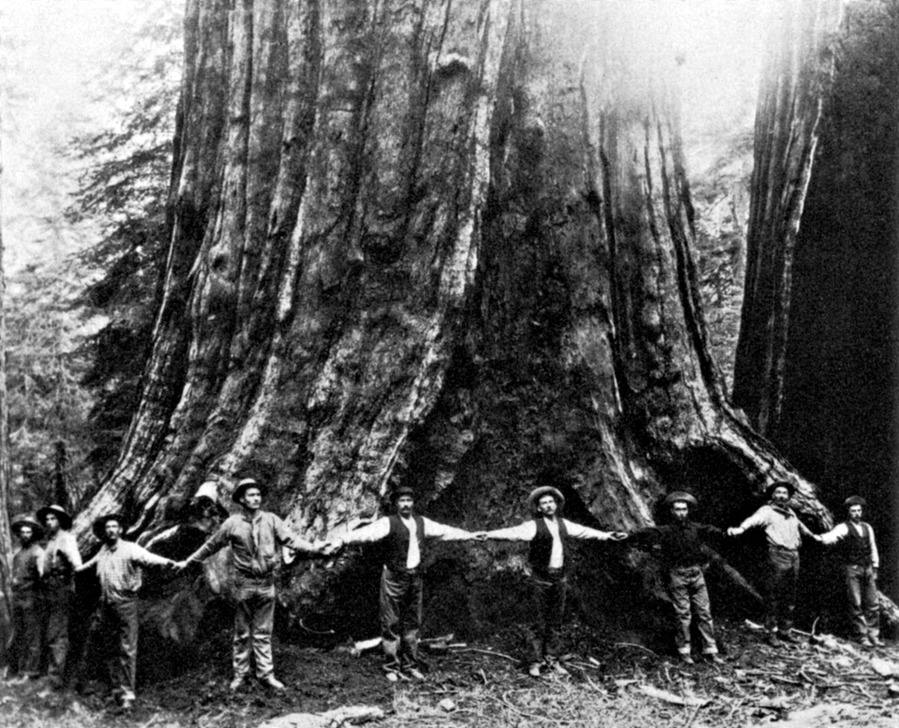 Lumberjacks link hands across the base of the General Noble tree before felling it. With a ground perimeter of 95 feet (measured on a slope), it was the largest tree ever cut down, and about 3,000 years old at the time. The General Noble Tree was cut down in 1892 to create an exhibit for the 1893 World's Columbian Exposition held in Chicago. The General Noble Tree was a Giant Sequoia tree from the Giant Sequoia National Monument of the Sierra Nevada, in Fresno County, California. The remains of the General Noble Tree are known as the Chicago Stump, which can be seen in the Converse Basin Grove. No photographer credited. AKG5465237 ©akg-images / Science Source
Lumberjacks link hands across the base of the General Noble tree before felling it. With a ground perimeter of 95 feet (measured on a slope), it was the largest tree ever cut down, and about 3,000 years old at the time. The General Noble Tree was cut down in 1892 to create an exhibit for the 1893 World's Columbian Exposition held in Chicago. The General Noble Tree was a Giant Sequoia tree from the Giant Sequoia National Monument of the Sierra Nevada, in Fresno County, California. The remains of the General Noble Tree are known as the Chicago Stump, which can be seen in the Converse Basin Grove. No photographer credited. AKG5465237 ©akg-images / Science Source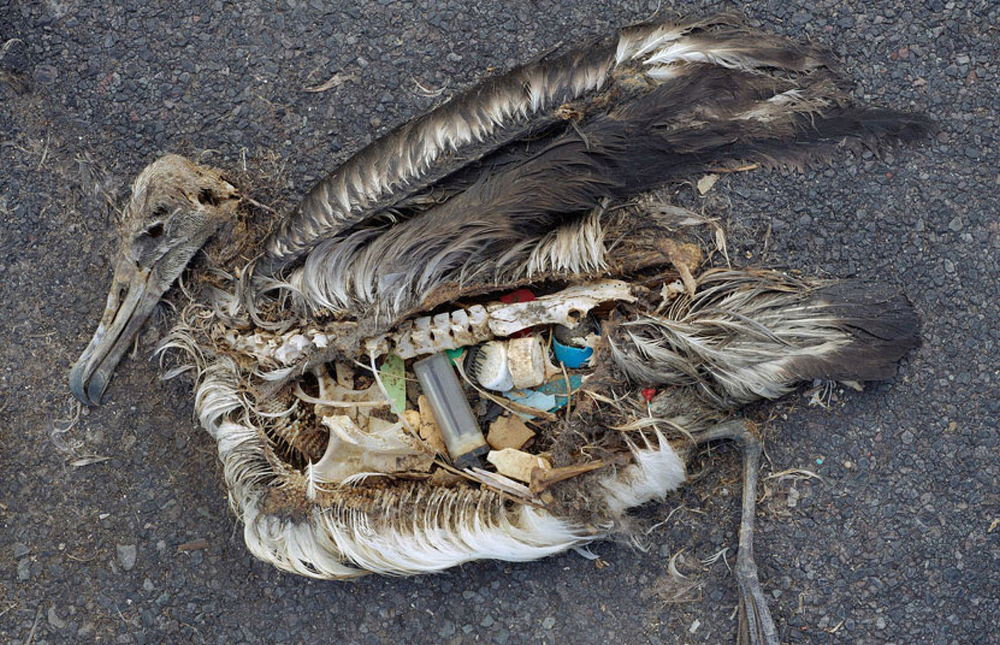.jpg) The unaltered stomach contents of a dead albatross chick photographed on Midway Atoll National Wildlife Refuge in the Pacific in September 2009 include plastic marine debris fed the chick by its parents. Marine animals cannot digest debris and often die due starvation. Marine debris, also known as marine litter, is human-created waste that has deliberately or accidentally been released in a lake, sea, ocean, or waterway. AKG8140199 ©akg-images / USFWS / Chris Jordan / SCIENCE SOURCE
The unaltered stomach contents of a dead albatross chick photographed on Midway Atoll National Wildlife Refuge in the Pacific in September 2009 include plastic marine debris fed the chick by its parents. Marine animals cannot digest debris and often die due starvation. Marine debris, also known as marine litter, is human-created waste that has deliberately or accidentally been released in a lake, sea, ocean, or waterway. AKG8140199 ©akg-images / USFWS / Chris Jordan / SCIENCE SOURCE.jpg) An alfalfa leafcutting bee (Megachile rotundata). AKG8124901 © akg-images / Nature Source/SCIENCE SOURCE
An alfalfa leafcutting bee (Megachile rotundata). AKG8124901 © akg-images / Nature Source/SCIENCE SOURCE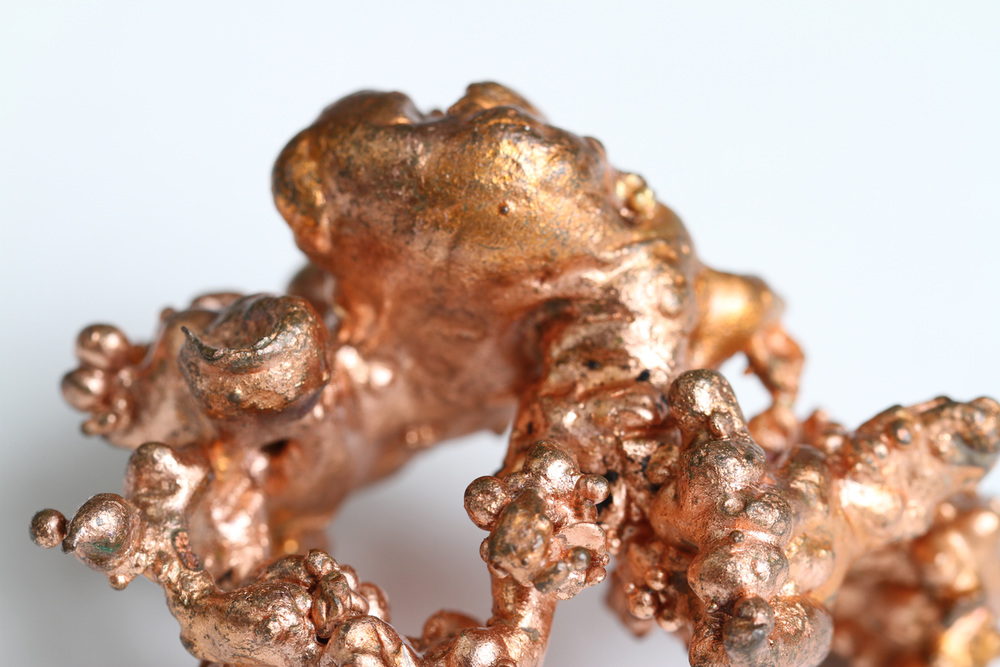 Copper specimen. Copper is one of only a few metals to occur in nature in elemental (native) form. It takes the form of reddish-brown nuggets of metal. AKG8125988 ©akg-images / PHOTO RF / SCIENCE SOURCE
Copper specimen. Copper is one of only a few metals to occur in nature in elemental (native) form. It takes the form of reddish-brown nuggets of metal. AKG8125988 ©akg-images / PHOTO RF / SCIENCE SOURCEClose Up
 Rods and cones of the retina. False color scanning electron micrograph (SEM) of rod (blue) and cone (green-blue) cells of the eye retina. Rod cells and less numerous cone cells are specialized light-sensitive cells. They occur on the surface of the retina. They are responsible for detecting visible images, which are transmitted as nerve impulses to the optic nerve and the brain. There are about 130 million rod cells in the human retina; they detect light intensity and so are important for day and night vision. While the less numerous cone-like cone cells (about 6.5 million in the human retina) respond specifically to color. Magnification unknown. Mag. approximately x2,000 at 35 mm size. AKG8195561 ©akg-images / Omikron / SCIENCE SOURCE
Rods and cones of the retina. False color scanning electron micrograph (SEM) of rod (blue) and cone (green-blue) cells of the eye retina. Rod cells and less numerous cone cells are specialized light-sensitive cells. They occur on the surface of the retina. They are responsible for detecting visible images, which are transmitted as nerve impulses to the optic nerve and the brain. There are about 130 million rod cells in the human retina; they detect light intensity and so are important for day and night vision. While the less numerous cone-like cone cells (about 6.5 million in the human retina) respond specifically to color. Magnification unknown. Mag. approximately x2,000 at 35 mm size. AKG8195561 ©akg-images / Omikron / SCIENCE SOURCE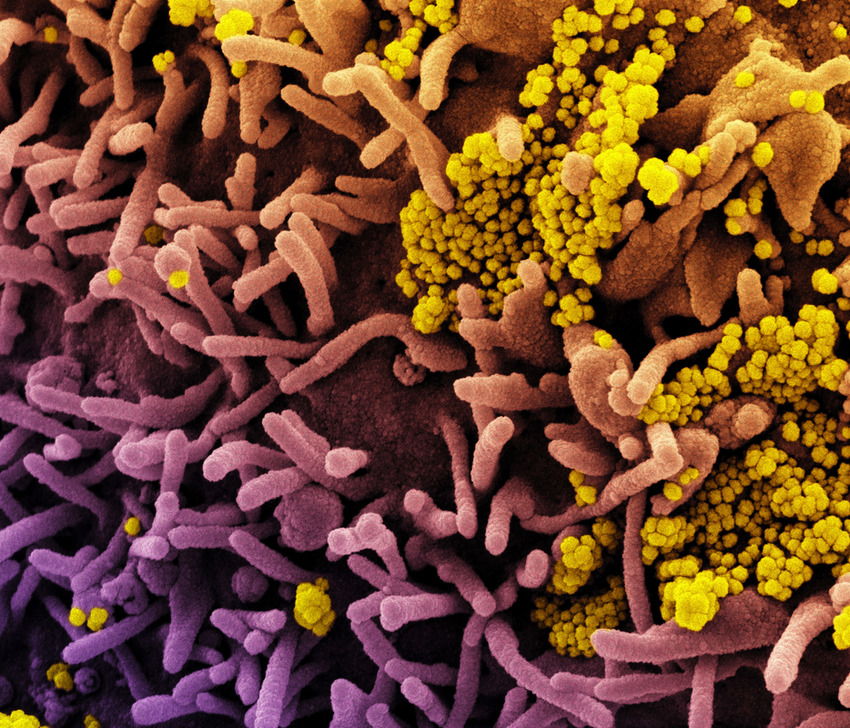 Colorized scanning electron micrograph of a cell (tan) infected with SARS-CoV-2 virus particles (yellow), isolated from a patient sample. Image captured at the NIAID Integrated Research Facility (IRF) in Fort Detrick, Maryland. AKG9036234 ©akg-images / Science Source
Colorized scanning electron micrograph of a cell (tan) infected with SARS-CoV-2 virus particles (yellow), isolated from a patient sample. Image captured at the NIAID Integrated Research Facility (IRF) in Fort Detrick, Maryland. AKG9036234 ©akg-images / Science Source.jpg)
The Human Body
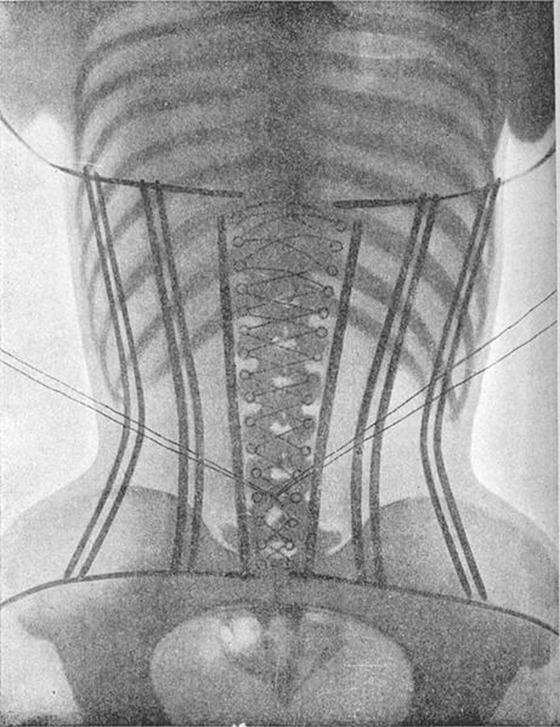 X-ray image (back view) of a woman wearing a corset from the second volume of the French doctor Ludovic O'Followell's Le Corset (1908). Although Dr O'Followell was clearly keen to show the damaging impact of corsets on women's health, he did not actually want the corset to be abolished, but was simply trying to encourage a less severe design. Dr O'Followell in fact continued to write a regular column for the deluxe corsetier's magazine Les Dessous Elegance. AKG5464527 © akg-images / Science Source
X-ray image (back view) of a woman wearing a corset from the second volume of the French doctor Ludovic O'Followell's Le Corset (1908). Although Dr O'Followell was clearly keen to show the damaging impact of corsets on women's health, he did not actually want the corset to be abolished, but was simply trying to encourage a less severe design. Dr O'Followell in fact continued to write a regular column for the deluxe corsetier's magazine Les Dessous Elegance. AKG5464527 © akg-images / Science Source Illustration detailing the various cells found in the human body. Shown here are cells from (bottom left, around to bottom right) sperm (male), the kidneys, the liver, bones, the lungs, the brain, blood, the heart, muscle, the pancreas and eggs (female). AKG8728312 ©akg-images / Science Source
Illustration detailing the various cells found in the human body. Shown here are cells from (bottom left, around to bottom right) sperm (male), the kidneys, the liver, bones, the lungs, the brain, blood, the heart, muscle, the pancreas and eggs (female). AKG8728312 ©akg-images / Science Source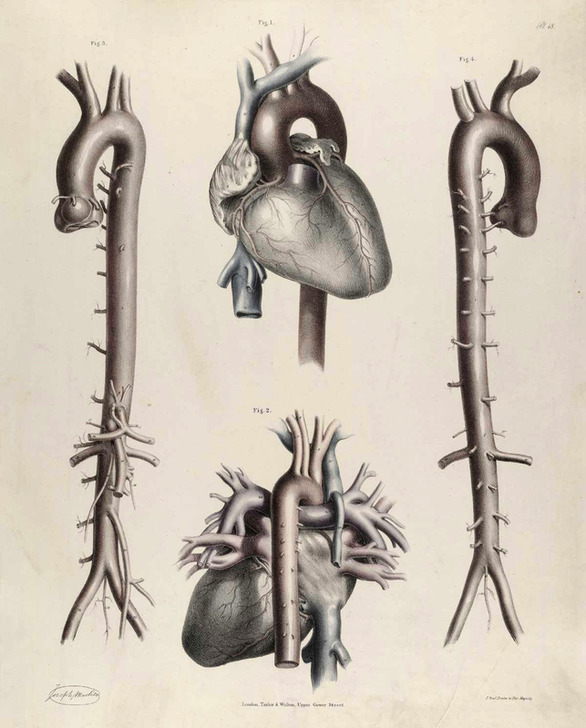 Illustration from the anatomy of the arteries of the human body with its applications to pathology and operative surgery. By Richard Quain, Published in 1844. AKG5441053 ©akg-images / Science Source
Illustration from the anatomy of the arteries of the human body with its applications to pathology and operative surgery. By Richard Quain, Published in 1844. AKG5441053 ©akg-images / Science Source This lateral view from a conventional 2D catheter cerebral angiogram was obtained following selective injection into the internal carotid artery. There is normal opacification of the anterior circulation. No significant abnormalities are seen. Note is made of filling of the inferolateral trunk (artery of the inferior cavernous sinus) with subsequent filling of distal internal maxillary artery branches. AKG8124387 ©akg-images / Medical Body Scans / SCIENCE SOURCE
This lateral view from a conventional 2D catheter cerebral angiogram was obtained following selective injection into the internal carotid artery. There is normal opacification of the anterior circulation. No significant abnormalities are seen. Note is made of filling of the inferolateral trunk (artery of the inferior cavernous sinus) with subsequent filling of distal internal maxillary artery branches. AKG8124387 ©akg-images / Medical Body Scans / SCIENCE SOURCE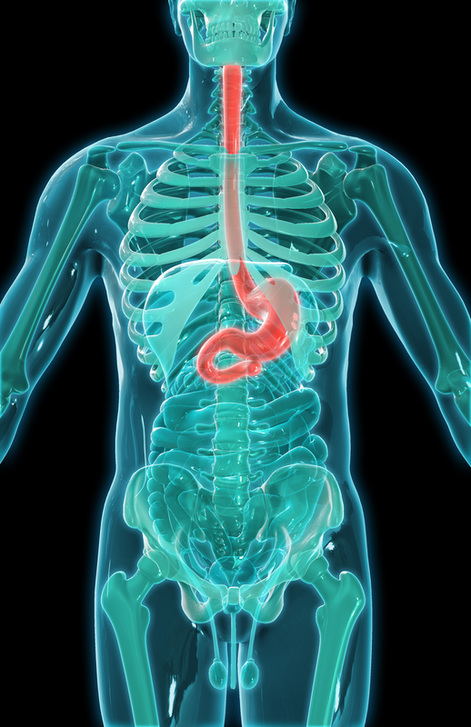 A 3D illustration of the abdominal organs seen within a model of the human skeleton, with the esophagus, stomach and duodenum highlighted in red. AKG8728685 ©akg-images / Science Source
A 3D illustration of the abdominal organs seen within a model of the human skeleton, with the esophagus, stomach and duodenum highlighted in red. AKG8728685 ©akg-images / Science Source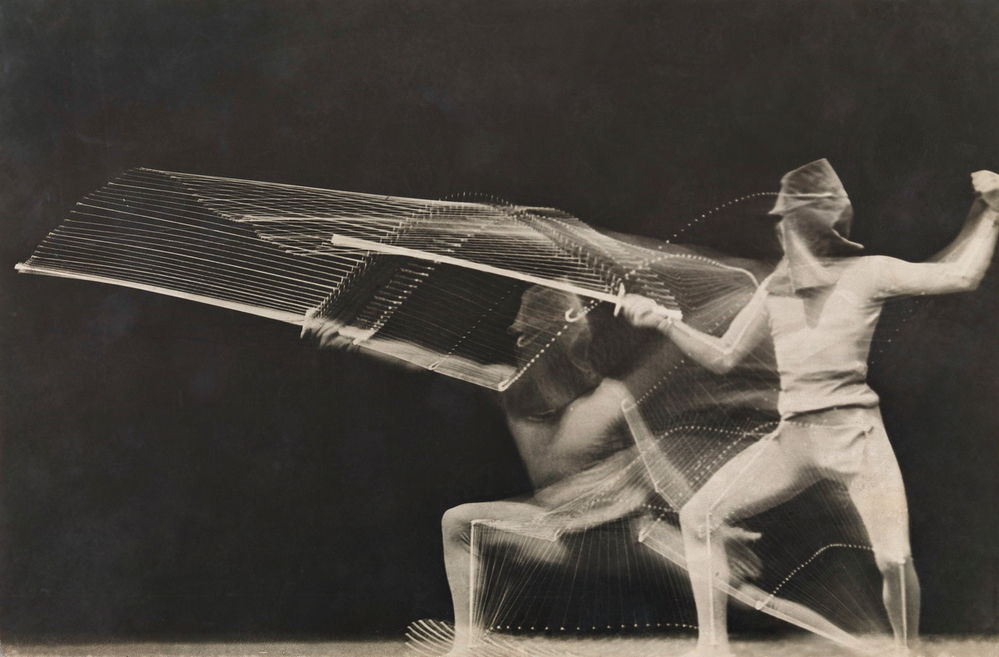
Portraits
Science and Politics

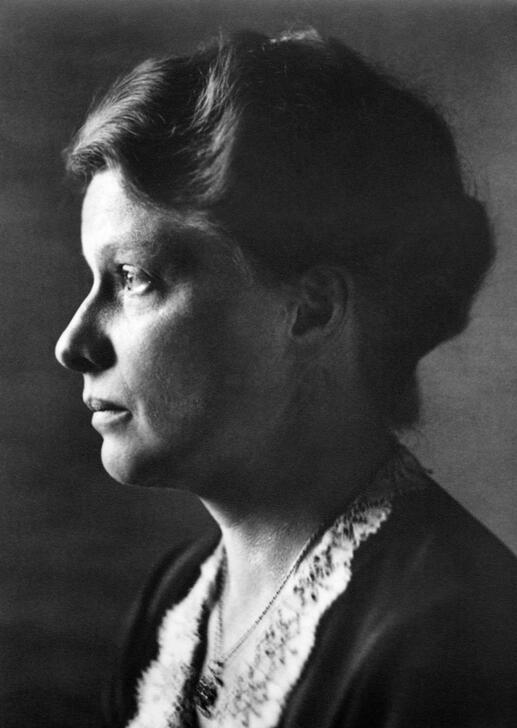 Hertha Sponer, German physicist and chemist who contributed to modern quantum mechanics and molecular physics. AKG9984406 ©akg-images / Science Source
Hertha Sponer, German physicist and chemist who contributed to modern quantum mechanics and molecular physics. AKG9984406 ©akg-images / Science Source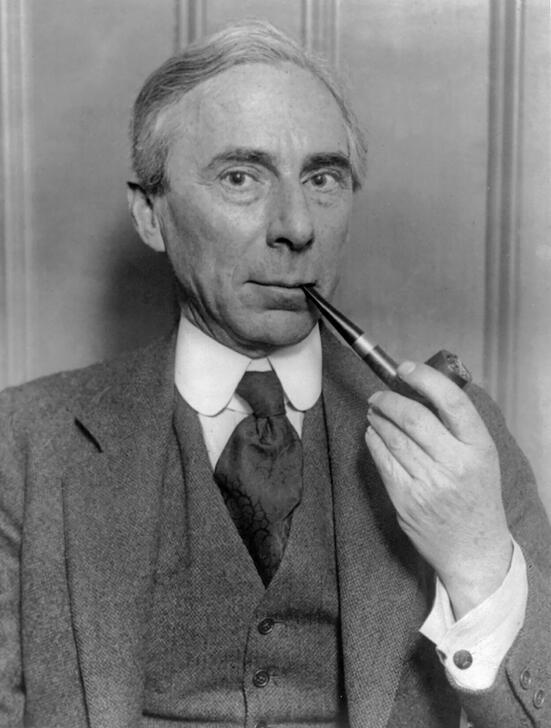 Bertrand Russell, British philosopher and logician. Russell was awarded the Nobel Prize in Literature in 1950. AKG9984314 © akg-images / Science Source
Bertrand Russell, British philosopher and logician. Russell was awarded the Nobel Prize in Literature in 1950. AKG9984314 © akg-images / Science Source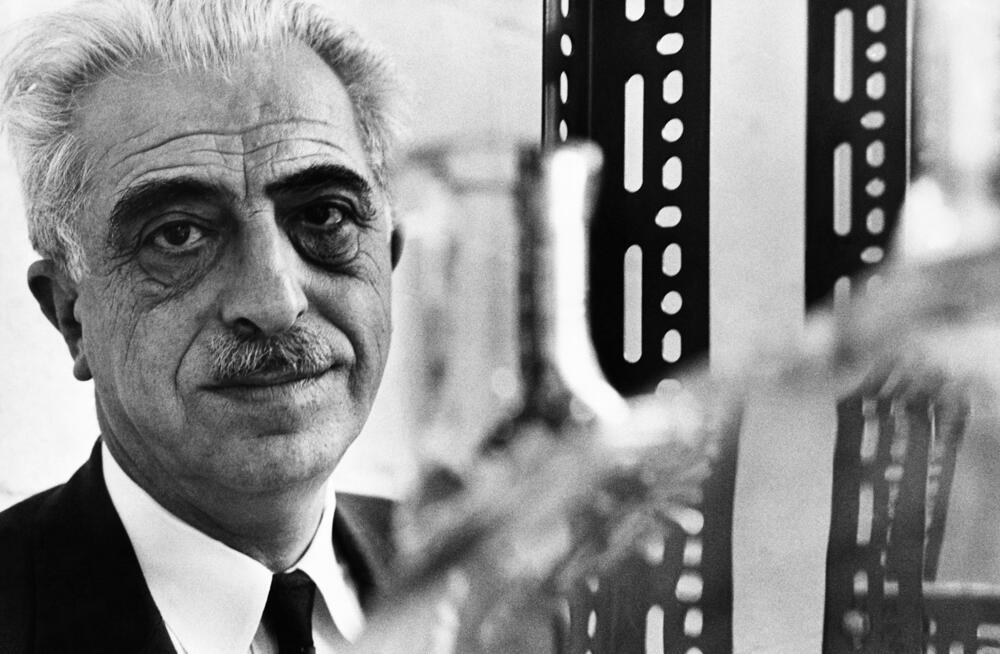 Dr Gregory Pincus, American biologist who developed the birth control pill. AKG9365538 ©akg-images / sciencesource / Inger McCabe
Dr Gregory Pincus, American biologist who developed the birth control pill. AKG9365538 ©akg-images / sciencesource / Inger McCabe Hannah Arendt (1906-1975), German-American historian and philosopher and political theorist, in 1933. Photographer unknown. Colorised. AKG11031758 © akg-images / Science Source
Hannah Arendt (1906-1975), German-American historian and philosopher and political theorist, in 1933. Photographer unknown. Colorised. AKG11031758 © akg-images / Science SourceArt
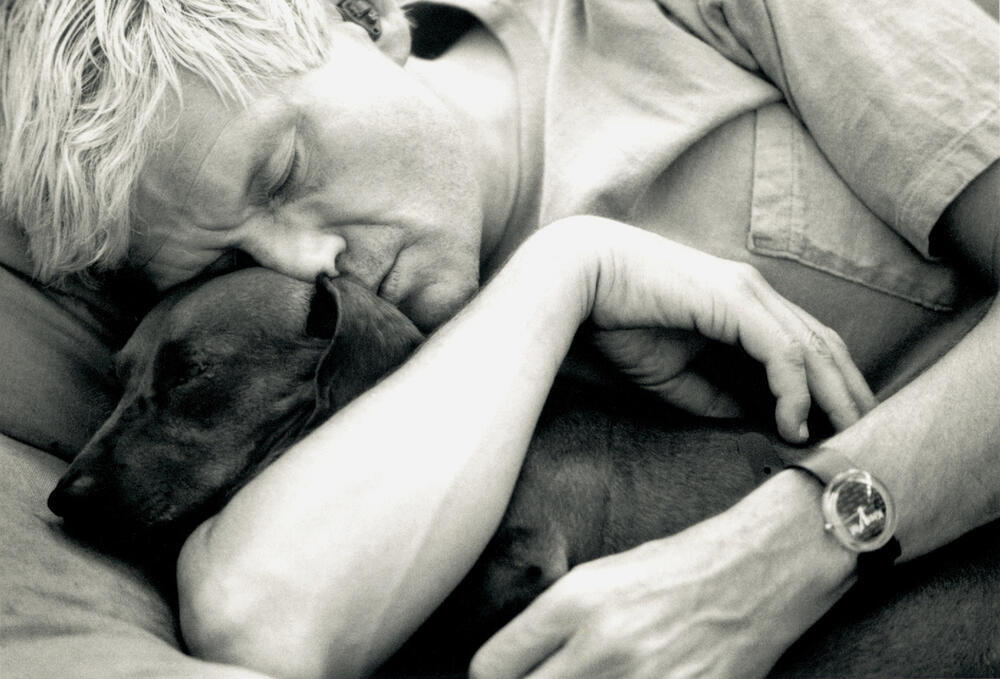
Music
Politics

.jpg) John F. Kennedy during his presidential visit to France, 1961. AKG9365281 ©John F. Kennedy (1917 - 1963) during his presidential visit to France from May 31st to June 2nd, 1961
John F. Kennedy during his presidential visit to France, 1961. AKG9365281 ©John F. Kennedy (1917 - 1963) during his presidential visit to France from May 31st to June 2nd, 1961 Two girls wearing "Abolish Child Slavery" banners in English and Yiddish. They were photographed at a labor parade held in New York City on May 1, 1909. AKG8729358 © akg-images / Science Source
Two girls wearing "Abolish Child Slavery" banners in English and Yiddish. They were photographed at a labor parade held in New York City on May 1, 1909. AKG8729358 © akg-images / Science Source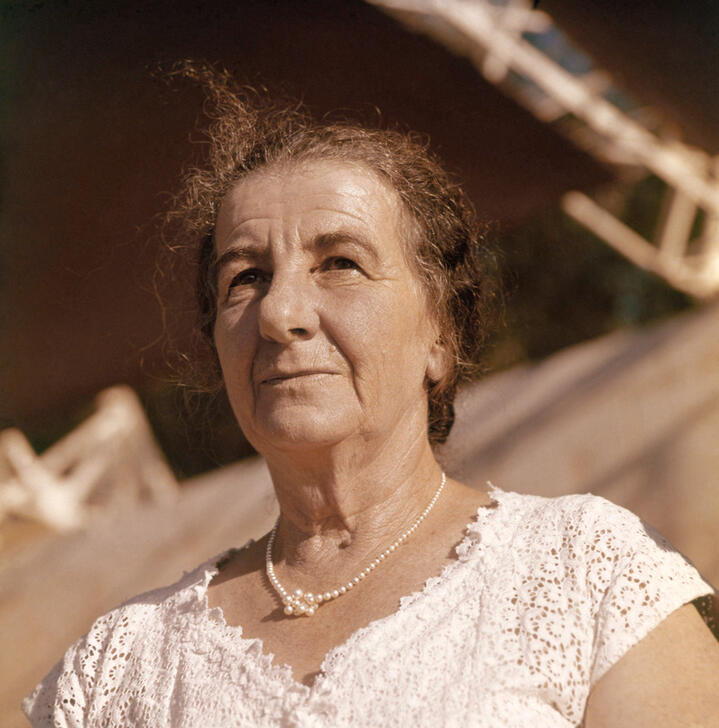 Golda Meir, Israeli Prime Minister, ca. 1969. AKG9365261 ©akg-images / sciencesource / A. Louis Goldman
Golda Meir, Israeli Prime Minister, ca. 1969. AKG9365261 ©akg-images / sciencesource / A. Louis Goldman Entitled: "We march with Selma!" On March 15, 1965, addressing a joint session of Congress, President Johnson called for new legislation to guarantee every American's right to vote. The same day roughly 15,000 marchers paraded in Harlem, New York, to support civil rights efforts in Alabama. The three Selma to Montgomery marches in 1965 were part of the Selma Voting Rights Movement and led to the passage that year of the Voting Rights Act, a landmark federal achievement of the 1960s American Civil Rights Movement. Activists publicized the three protest marches to walk the 54 mile highway from Selma to the Alabama state capital of Montgomery as showing the desire of black American citizens to exercise their constitutional right to vote, in defiance of segregationist repression. Photographed for the New York World Telegram & Sun photo by Stanley Wolfson, March 15, 1965. AKG5467857 © akg-images / Science Source
Entitled: "We march with Selma!" On March 15, 1965, addressing a joint session of Congress, President Johnson called for new legislation to guarantee every American's right to vote. The same day roughly 15,000 marchers paraded in Harlem, New York, to support civil rights efforts in Alabama. The three Selma to Montgomery marches in 1965 were part of the Selma Voting Rights Movement and led to the passage that year of the Voting Rights Act, a landmark federal achievement of the 1960s American Civil Rights Movement. Activists publicized the three protest marches to walk the 54 mile highway from Selma to the Alabama state capital of Montgomery as showing the desire of black American citizens to exercise their constitutional right to vote, in defiance of segregationist repression. Photographed for the New York World Telegram & Sun photo by Stanley Wolfson, March 15, 1965. AKG5467857 © akg-images / Science SourceSport
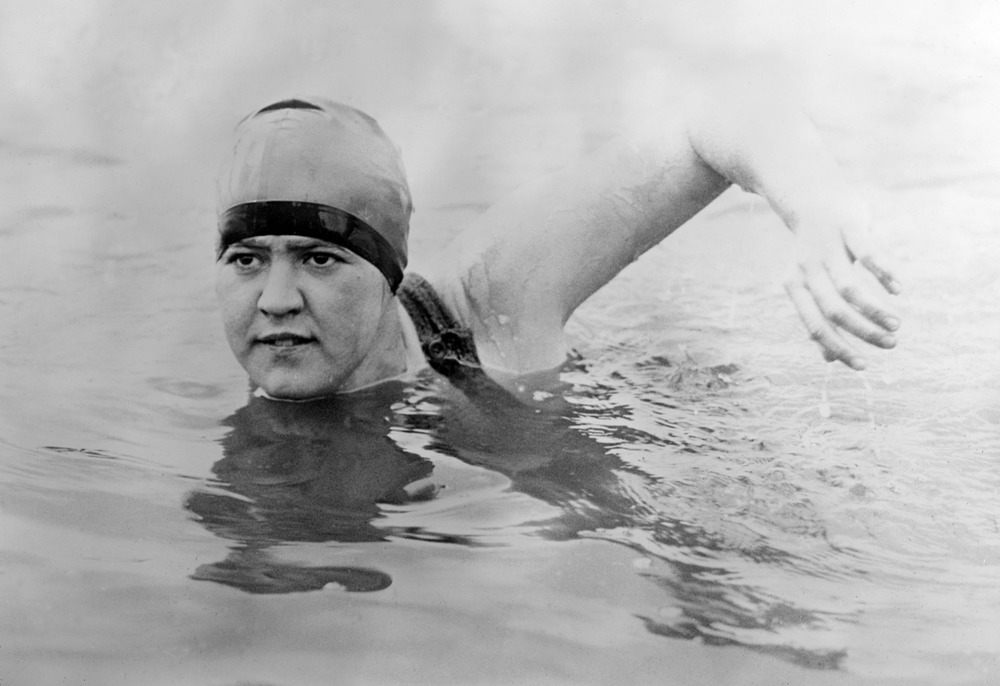 Gertrude Ederle, swimmer and first woman to swim across the English Channel. AKG5469154 © akg-images / Science Source
Gertrude Ederle, swimmer and first woman to swim across the English Channel. AKG5469154 © akg-images / Science Source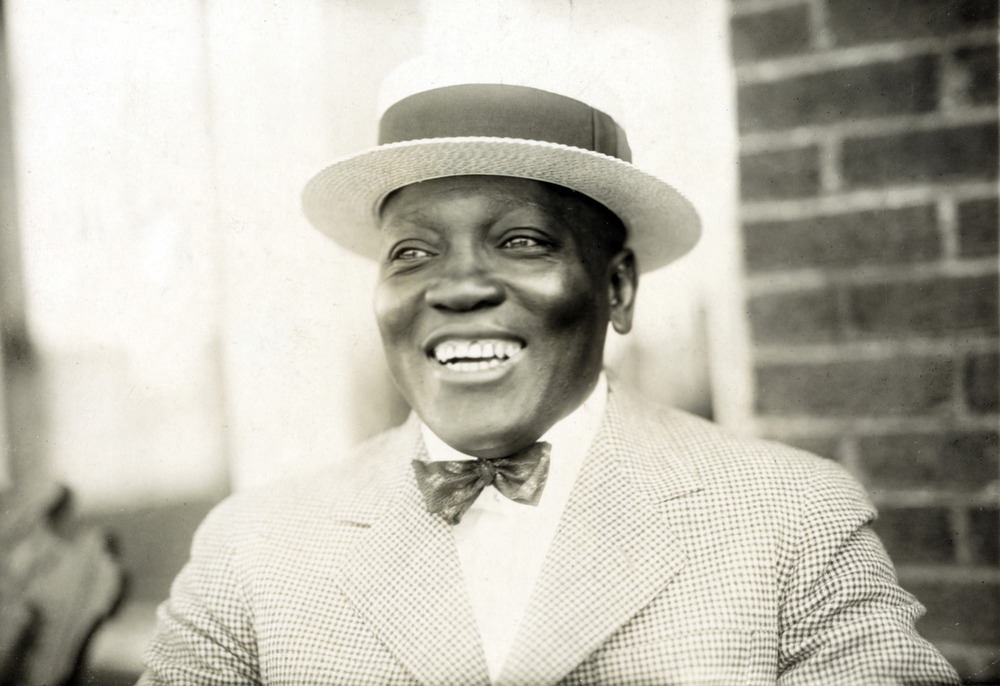 Jack Johnson, American boxer. AKG5462338 © akg-images / Science Source
Jack Johnson, American boxer. AKG5462338 © akg-images / Science Source.jpg) Pancho Barnes, pioneer aviator and stunt pilot. Undated AKG8147595 © akg-images / NYPL / Science Source
Pancho Barnes, pioneer aviator and stunt pilot. Undated AKG8147595 © akg-images / NYPL / Science Source Entitled: "Babe Ruth at bat, Garret catching." George Herman "Babe" Ruth, Jr. (February 6, 1895 - August 16, 1948) was an American baseball player who spent 22 seasons in Major League Baseball (MLB) playing for three teams (1914-1935). He originally entered the major leagues with the Boston Red Sox as a starting pitcher, but after he was sold to the New York Yankees in 1919, he converted to a full-time right fielder. He subsequently became one of the league's most prolific hitters and with his home run hitting prowess, he helped the Yankees win seven pennants and four World Series titles. Ruth retired in 1935 after a short stint with the Boston Braves, and the following year, he became one of the first five players to be elected into the National Baseball Hall of Fame. He is regarded as one of the greatest sports heroes in American culture. He died on August 16, 1948, of cancer at age 53. Photographed by National Photo Company, 1920. AKG5464002 © akg-images / Science Source
Entitled: "Babe Ruth at bat, Garret catching." George Herman "Babe" Ruth, Jr. (February 6, 1895 - August 16, 1948) was an American baseball player who spent 22 seasons in Major League Baseball (MLB) playing for three teams (1914-1935). He originally entered the major leagues with the Boston Red Sox as a starting pitcher, but after he was sold to the New York Yankees in 1919, he converted to a full-time right fielder. He subsequently became one of the league's most prolific hitters and with his home run hitting prowess, he helped the Yankees win seven pennants and four World Series titles. Ruth retired in 1935 after a short stint with the Boston Braves, and the following year, he became one of the first five players to be elected into the National Baseball Hall of Fame. He is regarded as one of the greatest sports heroes in American culture. He died on August 16, 1948, of cancer at age 53. Photographed by National Photo Company, 1920. AKG5464002 © akg-images / Science Source
Fascinating Finds

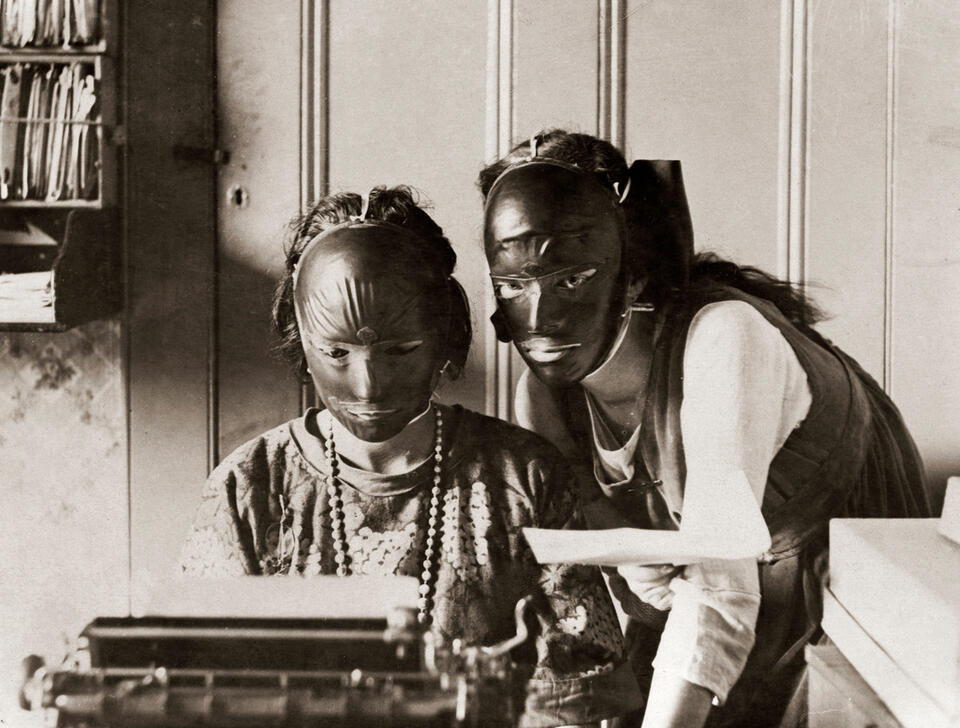 Rubber beauty masks, worn to remove wrinkles and blemishes; modeled by two women at a typewriter. Photograph, ca. 1921 AKG8442489 © akg-images / Wellcome Collection / SCIENCE SOURCE
Rubber beauty masks, worn to remove wrinkles and blemishes; modeled by two women at a typewriter. Photograph, ca. 1921 AKG8442489 © akg-images / Wellcome Collection / SCIENCE SOURCE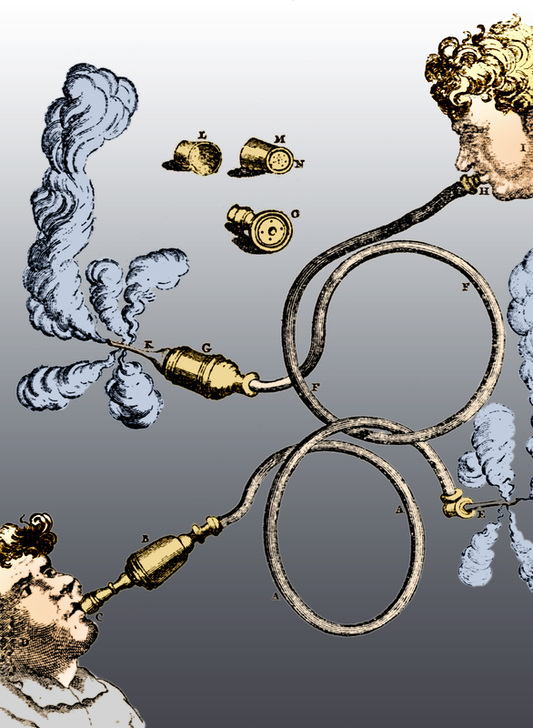 Clyster apparatus which uses tobacco smoke. An enema or clyster, is a fluid injected into the lower bowel by way of the rectum. The most frequent use of an enema is as a cleansing enema (also called a soapsuds enema) which is given to relieve constipation or for bowel cleansing before a medical examination or procedure. Etching from "" La Presse medicale"", 1903. Colorised. AKG9036527 © akg-images / Science Source
Clyster apparatus which uses tobacco smoke. An enema or clyster, is a fluid injected into the lower bowel by way of the rectum. The most frequent use of an enema is as a cleansing enema (also called a soapsuds enema) which is given to relieve constipation or for bowel cleansing before a medical examination or procedure. Etching from "" La Presse medicale"", 1903. Colorised. AKG9036527 © akg-images / Science Source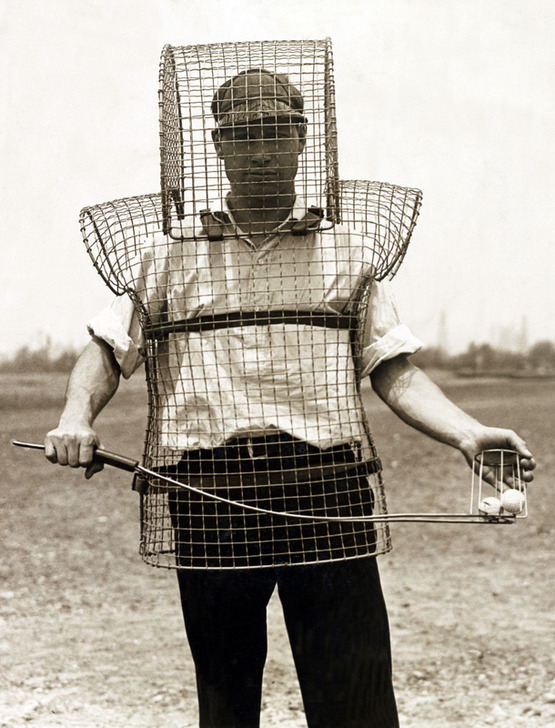 Golf Caddy Armor, Safety Device, 1920. AKG5467559 ©akg-images / Science Source
Golf Caddy Armor, Safety Device, 1920. AKG5467559 ©akg-images / Science Source Aerial Machine invented by Dr. W. O. Ayres of New Haven (1885) got its power from air compressed to 3.000 pounds per square inch in two drums. Air was supposed to feed through tubes to motors, last for several hours. The four horizontal propellers serve to give the craft sufficient lifting-power. They are driven not only by the compressed air but also by the legs of the rider thrusting on pedals similar to those used on bicycles. Attached to each cylinder of compressed air is a driving machine in which a paddle-wheel is brought into rotating motion by the flow of air. With his left hand the rider regulates the valve for air supply, while with his right arm he drives the vertically revolving propeller which thrusts the machine foreword. Appeared in Scientific American published May 9, 1885. AKG7417186 © akg-images / Science Source
Aerial Machine invented by Dr. W. O. Ayres of New Haven (1885) got its power from air compressed to 3.000 pounds per square inch in two drums. Air was supposed to feed through tubes to motors, last for several hours. The four horizontal propellers serve to give the craft sufficient lifting-power. They are driven not only by the compressed air but also by the legs of the rider thrusting on pedals similar to those used on bicycles. Attached to each cylinder of compressed air is a driving machine in which a paddle-wheel is brought into rotating motion by the flow of air. With his left hand the rider regulates the valve for air supply, while with his right arm he drives the vertically revolving propeller which thrusts the machine foreword. Appeared in Scientific American published May 9, 1885. AKG7417186 © akg-images / Science SourceWe're ready to help you find the perfect images for your projects. You can get in touch using the details below.
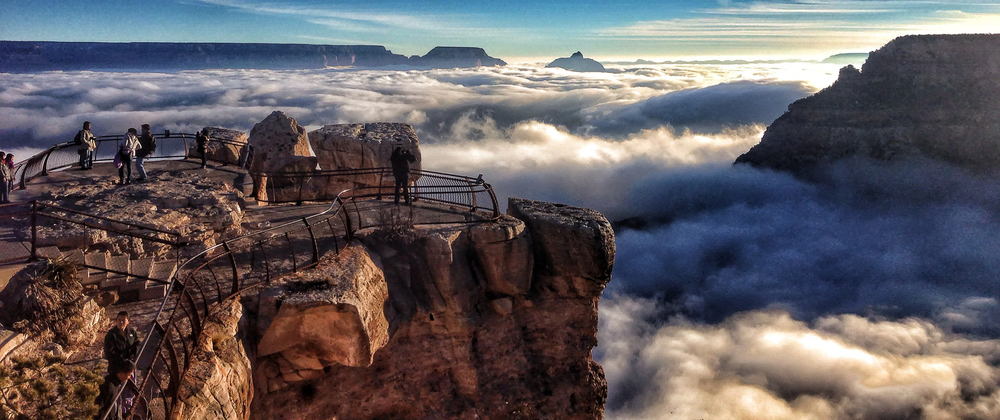

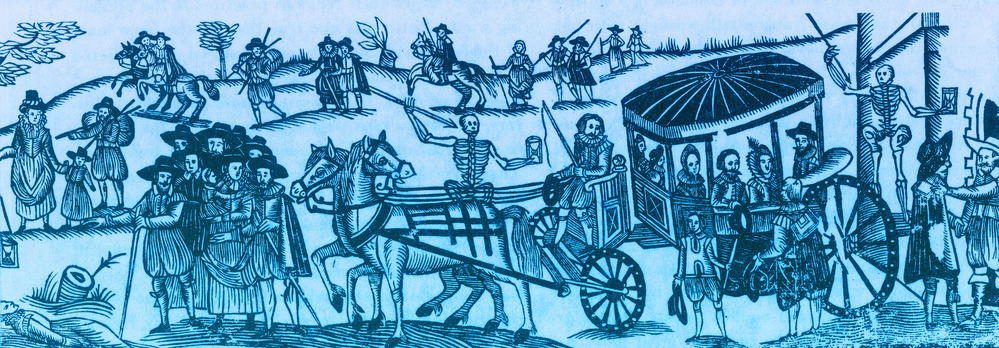
.jpg)
